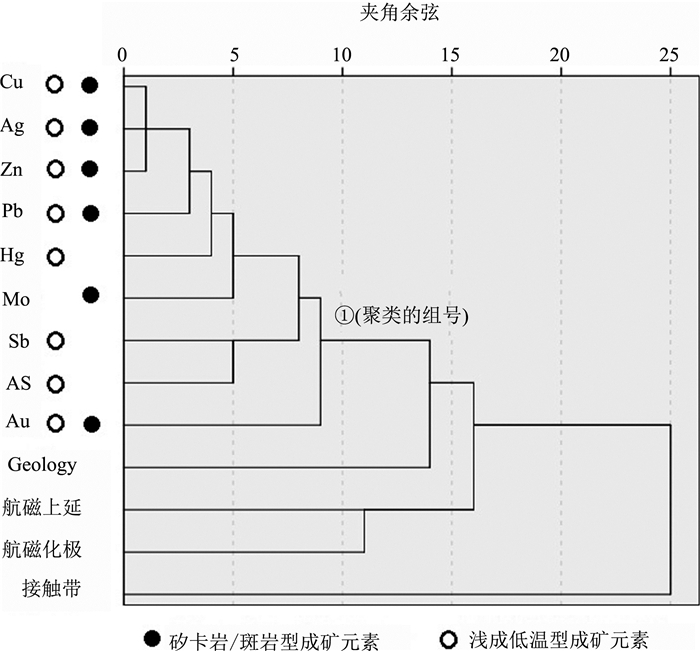Recognition and identification of spatial mineralization patterns
-
摘要:
使用现代信息技术,基于空间数据圈定矿化分布和找矿目标,是当前矿产勘查的一个新方向。采用模糊聚类方法,以地质、地球物理和地球化学图层为输入数据,在GIS平台上对空间矿化模式进行识别,并通过地质解读从中鉴别出矿化模式。模糊聚类是基于c-means聚类的人工神经网络方法,以模糊隶属度作为不确定性推理指标,是一种非监督分类器。用这一方法进行空间矿化模式识别,可以在多种矿床类型共存和交叉重叠分布的环境中,识别并鉴别出个性化的矿化模式。以内蒙古乌兰浩特1:20万图幅为例,展示了模糊聚类空间矿化模式的识别与鉴别过程,取得了良好的效果。
Abstract:A recent development in mineral exploration is the use of information technology to define the distribution of mineralization and prospecting targets using spatial data.With geological, geophysical, and geochemical map layers as input data, fuzzy clustering was used in this study to recognize spatial patterns on the GIS platform, and the mineralization patterns were identified by geological interpretation.Fuzzy clustering is a hybrid spatial pattern recognition method composed of c-means clustering, neural network and fuzzy sets.Being an unsupervised classifier, it uses fuzzy membership as an uncertain measurement of the spatial pattern recognition.In the complex distribution environment where diverse deposit types coexist and intersect, different individualized mineralization patterns can be recognized and identified.This study illustrates the technique of fuzzy clustering spatial mineralization pattern recognition and identification, with successful results, using the 1:200 000 map of Ulanhot, Inner Mongolia as an example.
-

-
表 1 空间矿化模式鉴别
Table 1. Criteria for spatial mineralization pattern identification
空间模式组号 空间模式号 已知典型矿床 空间分布特征 地质特征 地球化学、地球物理特征 目标矿床类型 已知矿床数 6 PAT21 神山金-钼-铅-铁-铜-锌-银矿床 研究区西部,南西—北东方向线上 下二叠统大石寨组火山-碎屑岩-大理岩系(P1ds),下二叠统神山组(P1sh)碎屑岩、灰岩及安山岩,燕山早期花岗斑岩、斜长花岗斑岩、花岗闪长斑岩(γπ52c) 异常:Zn-Mo-Hg-Cu-Ag强,航磁化极异常范围0~+150 矽卡岩型 2 6 PAT25 白音花旗西金-银-铜矿床 斜贯图幅南西—北东向展布 上侏罗统大磨拐河碎屑岩系(J3d),上侏罗统中兴安岭火山-凝灰岩系(J3z),下二叠统神山组(P1sh)碎屑岩、灰岩及安山岩 异常:Zn-Sb-Hg-Au-As强,航磁化极异常范围0~+150 矽卡岩型
斑岩型
浅成低温
热液型7 5 PAT17 宝龙山铜-钼-银矿床 图幅东南端,南西—北东方向展布背景弱 海西晚期花岗岩(γ43-2b),上侏罗统中兴安岭火山-凝灰岩系(J3z) Au- Hg-As强,航磁化极异常范围0~+150 斑岩型
浅成低温
热液型2 6 PAT6 小巴音胡硕金-铜-银矿床 图幅西北部,显示南西—北东方向展布背景 下二叠统大石寨组火山-碎屑岩-大理岩系(P1ds),下二叠统神山组(P1sh)碎屑岩、灰岩及安山岩,燕山晚期花岗正长岩岩组(γξ53)、燕山早期花岗斑岩、斜长花岗斑岩、花岗闪长斑岩(γπ52c) 异常:Mo强,Au零散中等异常,航磁化极异常范围0~+150 矽卡岩型 6 6 PAT20 后六九铜-钼矿床龙江六九铜-银矿床 图幅东部,呈清晰的南西—北东方向展布特征 上侏罗统上兴安岭中酸性火山岩组(J3s),上侏罗统中兴安岭火山-凝灰岩系(J3z),上侏罗统大磨拐河碎屑岩系(J3d),燕山早期花岗斑岩、斜长花岗斑岩、花岗闪长斑岩(γπ52c) 异常:Mo-As强,Sb中—强,Pb中—强,航磁化极异常范围0~+150 斑岩型、浅成低温型 3 2 PAT23 大黑山金-铜-铁矿床 位于中偏西部 上侏罗统大磨拐河碎屑岩系(J3d),上侏罗统上兴安岭中酸性火山岩组(J3s),下二叠统大石寨组火山-碎屑岩-大理岩系(P1ds) 异常:Mo-Pb-As强,航磁化极异常范围0~+150 矽卡岩型、浅成低温型 13 表 2 空间矿化模式包含的已知矿床统计
Table 2. Statistical information of known deposits included in spatial mineralization patterns
矿床 PAT21 PAT25 PAT17 PAT6 PAT20 PAT23 胡镇西五棵树 * * 小巴音胡硕 * / 扎兰屯西 * / / 神山 * * 扎兰屯北 / * * 白音苏木 * / 乌兰毛苏木 * / 育林 * / / 林业队 * * 大黑山 * * 居鲁河 * 查干居鲁河1 * 查干居鲁河2 * 东茫 白音花旗西 * * * 宝龙山 * 龙江六九 / * 后六九 * 哈拉 * * 注:*表示矿床矿点在矿化模式核心区,/表示在边缘 -
[1] Alliams M. Method of appraising economic prospects of mining exploration over large territories - Algerian Sahara case study[J]. Management Sci., 1957, 3(4): 285-345.
[2] Agterberg F P, Davi S R. A statistical method for the distribution of copper, lead and zinc in the Canadian Appalachian region[J]. Eco. Geol., 1978, 73(2): 230-245. doi: 10.2113/gsecongeo.73.2.230
[3] Harris D P. Mineral resourcesappraisal - mineral endowment, resource, and potential supply: concepts, methods, and cases[M]. Oxford University Press, 1984: 1-464.
[4] 赵鹏大, 胡旺亮, 李紫金. 矿床统计预测[M]. 北京: 地质出版社, 1994: 1-314.
[5] Bonham-Carter G, Agterberg F P, Wright D F. Weights of evidence modeling: a new approach to mapping mineral potential[C]//Statistical Applications in the Earth Sciences, Canadian Government Publishing Centre, Ottawa, 1989: 171-183.
[6] Rains G, Bonham-Carter G. Introduction to special issue to on spatial modeling in GIS[J]. Natural Resources Research, 2007, 16(2): 81-84. doi: 10.1007/s11053-007-9041-x
[7] Korytkowski M, Scherer R, Tadeusiewicz R, et al. Artificial Intelligence and Soft Computing[C]//Proceedings, Part Ⅱ, 15th International Conference. ICAISC, Poland, 2016.
[8] Paris J, Vencovska A. Principles of uncertain reasoning[C]//Philosophy and Cognitive Categories, Consciousness, and Reasonong. Springer, 1996: 221-259.
[9] 李裕伟, 赵金满, 李晨阳. 基于GMS、DSS和GIS的潜在矿产资源评价方法[M]. 北京: 地震出版社, 2007: 1-946.
[10] 张尧庭, 杜劲松. 人工智能中的概率统计方法[M]. 北京: 科学出版社, 1998.
[11] Looney C G. Interactive clustering and merging with a new fuzzy expected value[J]. Pattern Cognition, 2002, 35(11): 2413-2423. doi: 10.1016/S0031-3203(01)00213-8
[12] Raines G, Bonhan-Carter G. Introduction to special issue on spatial modeling in GIS[J]. Natural Resources Research, 2007, 16(2): 81-84. doi: 10.1007/s11053-007-9041-x
[13] Xie X L, Beli G. A validity measure for fuzzy clustering[J]. IEEE Trans. Pattern Analysis and Machine Intelligence, 1991, 13(8): 841-847. doi: 10.1109/34.85677
[14] Looney C G. Fuzzy connectivity clustering with radial basis kernel functions[J]. Fuzzy Sets and Systems, 2009, 160(13): 1868-1885. doi: 10.1016/j.fss.2008.12.010
[15] 马骏超, 刘桂香, 张德宝, 等. 内蒙古扎赉特旗神山铁铜矿床地质特征及找矿标志[J]. 地质与资源, 2018, (3): 225-256. https://www.cnki.com.cn/Article/CJFDTOTAL-GJSD201803006.htm
[16] 李德胜. 黑龙江省龙江县后六九铜钼矿床地质特征及成因初探[J]. 矿产与地质, 2003, 17(97): 354-357. https://www.cnki.com.cn/Article/CJFDTOTAL-KCYD2003S1026.htm
[17] 梁培基. 黑龙江省龙江县六九山铜银矿矿床地质特征及找矿标志[D]. 石家庄经济学院硕士学位论文, 2015: 1-240.
[18] 古阿雷, 孙景贵, 白令安, 等. 大兴安岭中段闹牛山浅成热液多金属矿床流体包裹体研究[J]. 矿物岩石, 2018, 38(153): 28-39. https://www.cnki.com.cn/Article/CJFDTOTAL-KWYS201803005.htm
[19] 金若时, 刘永顺, 张跃龙, 等. 大兴安岭中南段昌图锡力锰、银、铅、锌多金属矿床的发现及其意义[J]. 地质通报, 2017, (7): 1268-1275. doi: 10.3969/j.issn.1671-2552.2017.07.016 http://dzhtb.cgs.cn/gbc/ch/reader/view_abstract.aspx?file_no=20170716&flag=1
[20] 马一行, 吕志成, 颜廷杰, 等. 内蒙古昌图锡力地区重磁场特征与深部找矿指示[J]. 地质通报, 2020, 39(8): 1258-1266. http://dzhtb.cgs.cn/gbc/ch/reader/view_abstract.aspx?file_no=20200813&flag=1
[21] 鄂阿强, 杜青松. 大兴安岭地区小巴音胡硕铜多金属矿床地质特征[J]. 内蒙古科教经济, 2016, (20): 62-64. https://www.cnki.com.cn/Article/CJFDTOTAL-NMKJ201620030.htm
[22] 吴燕平. 内蒙古扎赉特旗大黑山区金铜铁矿矿床特征及找矿远景[D]. 吉林大学硕士学位论文, 2013: 1-62.
-




 下载:
下载:




